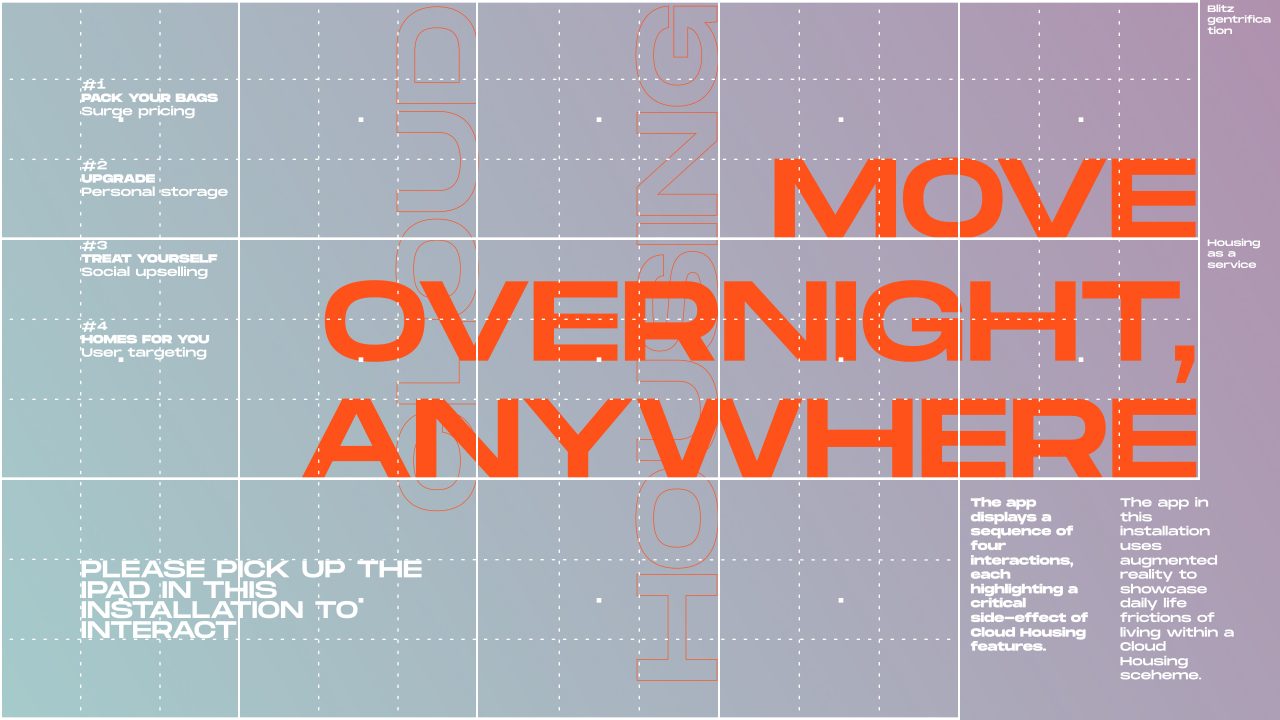
Lucia Tahan was trained as an architect and works as a product designer for a tech company, but is also active as an artist. Within the frame of Housing the Human, she imagines a future scenario that can be experienced through an augmented reality application that she is designing and developing in collaboration with Mandy Mandelstein.
Anja Neidhardt: What is the topic of your project and what research question are you following?
Lucia Tahan: In my project Cloud Housing, I ask about the impact tech companies and their products have on living, housing, and the city in general. What are the consequences of these platforms? And how can we influence the future through using tech products?
AN: What kind of platforms do you mean?
LT: Airbnb, for example, has empowered many users to meet other people and enabled them to feel like a local in any city. But it also caused fast and extreme gentrification. Architects, urban planners, and policy makers reacted late because this development was unforeseeable. I was an Airbnb host for a long time, one of the pioneers, and I really believed in it. I didn’t see things coming. This is part of the reason why I’m doing this project now. Today, quite a few tech companies are investigating how urban spaces, working environments, or distribution centers can be optimized, and housing will be the next frontier.

AN: What does your research look like?
LT: I imagine a company that might exist in the future and offer a product that a specific group of people could want. What would the implications be, if this product were successful? I’m trying to communicate that to the public by involving them.
AN: Who’s your audience?
LT: The public that visits the exhibitions of Housing the Human. However, there are also curators, architects, and other experts coming to debate with us. I think planting this idea into their minds could be impactful, too. Architects, politicians, and the broader public only began to speak about Airbnb when it had already become a new force in the market. Had they started talking about it earlier, perhaps the solutions would have been more fully formed by the time those effects started to take place.
AN: How can people interact with your research?
LT: I’m presenting my research with the help of an augmented reality app, mimicking the experience of living in an apartment developed by this new imaginary company. Through a series of prompts, users are asked to upgrade their subscription or leave the apartment. Each of these interactions is presented with the typical friendly tone of a tech product, but this can be a jarring experience. The imaginary company offers “instant housing,” which means you subscribe to housing in order to gain access to apartments and move whenever you want. But this can also lead to instant gentrification. Depending on your subscription, you could be prompted to leave overnight, which is highlighted in the app as “Pack your bags, you are leaving tomorrow. We will pick you up.

AN: What does the apartment in your application look like?
LT: It’s inspired by the aesthetics of our social-media consumption. Compared to the past, people today photograph the interiors of their homes much more, to share online. So having a beautiful home, even if you don’t invite anybody over, becomes very important and part of how people define themselves.
AN: What is Mandy Mandelstein’s role in Cloud Housing?
LT: Mandy and I work together to figure out how to best design with AR technology to bring the idea to life for the exhibitions. I design the interfaces and interactions, and she codes them. I showed the app at the Copenhagen Architecture Festival in April. It is actually a complement to visualizing a physical room that I will be building now in Berlin. My idea is that a person sees a beautiful apartment through the app while actually being in a completely alienated physical space.
AN: What feelings do you want to inspire with your app?
LT: Ambivalence, and hopefully a sense of empowerment. When tech companies offer a product through subscription, their main goal is to understand what their users want, and give it to them. The users communicate their wishes through their interactions with the product, which is very empowering. What we want to communicate is entirely up to us.
AN: Well, only to a certain extent. There’s always a given frame.
LT: Yes, of course. Interaction is a radically new communication channel, like a new language that we’ve just learned to speak. Expression is always limited and, often, the more collective the message, the more limited the range.
AN: Isn’t there a risk of people feeling powerless or disillusioned after using your app?
LT: I’m an optimist. This imagined future has not happened yet. There is time to include new voices in the conversation, reexamine our role as users of tech, and feel empowered to shape our own future collectively. That’s the whole point. I don’t think people feel put down by the whole thing. When I present this work, people actually say: “What if I don’t want to live in that future?” That’s great; they are questioning it.